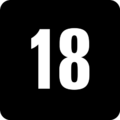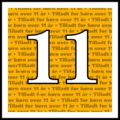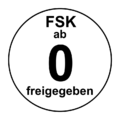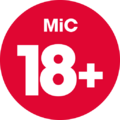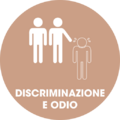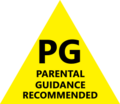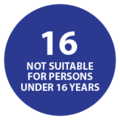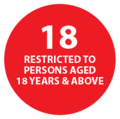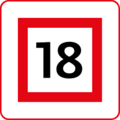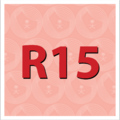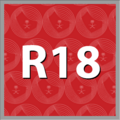Motion picture content rating system facts for kids
Have you ever wondered why some movies are okay for everyone to watch, while others are only for older kids or adults? That's because of the motion picture content rating system. This system sorts films based on what's in them, like fighting, scary scenes, or bad language. It helps people, especially parents, decide if a movie is right for their family.
Most countries have a rating system. These ratings are sometimes called certifications or classifications. They often suggest an age for the audience. Sometimes, these are just suggestions, but other times, they are strict rules. For example, a movie theater might be required by law to check IDs for a movie with a restrictive rating.
Who decides these ratings? It's different in each country. In places like Australia and Canada, a government group makes the decision. In other countries, like the United States, groups from the movie industry itself decide the ratings. In almost all countries, there are laws to stop kids from seeing certain movies, even if there isn't a specific rating.
When deciding on a rating, people look at many things. They might consider if a movie shows violence in a way that makes it seem cool, or if it's part of a true story. For example, in Germany, movies about real historical wars might be treated differently than movies with made-up fighting.
Sometimes, a movie is made with a specific rating in mind. If it gets a higher rating than the filmmakers wanted, they might re-edit it by cutting out certain scenes to get the rating they want. A movie might also be changed to have a different version for another country.
Comparison table
This table compares the movie rating systems from different countries. The ages are shown across the top. But remember, just because two ratings use the same color or age doesn't mean they are the same. The rules for how a rating is given can be very different from one country to another.
Here is what the colors in the table mean:
- White – No restrictions: Good for all ages or not rated.
- Yellow – Suggestion: Parents might want to watch with their kids.
- Purple – Strong suggestion: Not recommended for younger kids, but not a strict rule.
- Red – Restricted: A parent or adult must be with younger kids.
- Black – Not allowed: Only for older audiences or banned completely.
Australia
In Australia, the Classification Board is a government group that classifies all movies shown to the public.
Advisory categories
These ratings are suggestions.
- G (General) – Suitable for everyone.
- PG (Parental Guidance) – Parents are encouraged to watch with children under 15. The movie has mild content.
- M (Mature) – Recommended for mature audiences. It's not recommended for kids under 15.
Restricted categories
These ratings are strict rules.
- MA 15+ (Mature Accompanied) – You must be 15 or older to watch. If you are under 15, you must have a parent or adult guardian with you.
- R 18+ (Restricted) – You must be 18 or older to watch.
- RC (Refused Classification) – These movies are banned and cannot be sold or shown in the country.
Canada
In Canada, each province has its own rules for rating movies. However, most provinces (except for Quebec) use a similar system.
Classifications used outside Quebec
- G – Good for all ages.
- PG (Parental Guidance) – Parents are advised to check the movie out. It might not be good for very young children.
- 14A – You should be 14 or older. If you're younger, you need to be with an adult.
- 18A – You should be 18 or older. If you're younger, you need to be with an adult. In some provinces, you must be at least 14 to see these movies, even with an adult.
- R (Restricted) – You must be 18 or older.
- E (Exempt) – The movie doesn't need a rating, like some sports or educational films.
United Kingdom
The British Board of Film Classification (BBFC) gives ratings to movies in the UK. Local governments can change these ratings if they want.
- U (Universal) – Suitable for everyone, usually ages four and up.
- PG (Parental Guidance) – Anyone can watch, but some scenes might not be good for young kids. It should be okay for a child who is eight or older.
- 12A / 12 – For people 12 and over. In a cinema, someone under 12 can see a 12A movie if they are with an adult. For home videos, no one under 12 can rent or buy a 12-rated movie.
- 15 – You must be 15 or older to see this movie in a cinema or to buy it.
- 18 – You must be 18 or older.
- R18 – These are for adults only and can only be shown in special licensed cinemas or sold in licensed shops.
United States
In the United States, movie ratings are given by the Motion Picture Association (MPA). This is a voluntary system, meaning filmmakers don't have to get a rating, but most do.
- G (General Audiences) – Anyone can watch.
- PG (Parental Guidance Suggested) – Some parts of the movie may not be suitable for children.
- PG-13 (Parents Strongly Cautioned) – Some parts may be inappropriate for kids under 13.
- R (Restricted) – If you are under 17, you must have a parent or adult guardian with you.
- NC-17 (Adults Only) – No one 17 and under is allowed to watch.
Images for kids
See also
 In Spanish: Clasificación por edades (cine) para niños
In Spanish: Clasificación por edades (cine) para niños
- Television content rating system
- Video game content rating system
- Mobile software content rating system






































